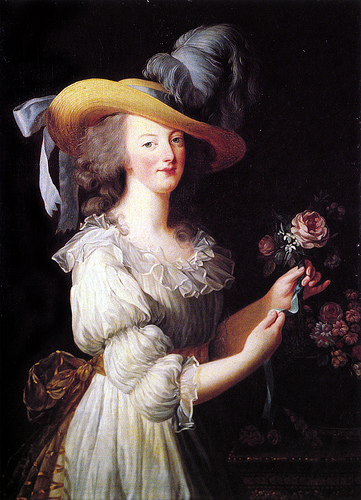
Portrait of Marie Antoinette 1783 (Marie Antoinette in a Muslin Dress). Elisabeth Vigée-Lebrun. Source: Wikimedia Commons
In 1783, the artist Elisabeth Vigée-Lebrun painted a portrait of Marie-Antoinette. La Reine en Gaulle was included in the public exhibition at the Salon du Louvre. In the painting, Marie Antoinette wore a gown in a style called gaulle. This meant a simple white muslin dress that fit relatively loosely over the body and had a sash around the waist. Marie Antoinette also wore a wide-brimmed, be-feathered straw hat and held a rose.
It may seem innocuous to us, but this portrait caused quite a stir when it was presented to the public. The simplicity of the portrait was in stark contrast to usual royal portraiture. The queen was shown in marked informality instead of in the regal, formal grand habit that a queen of France would usually wear in a portrait. Marie Antoinette was, once again, flying in the face of tradition by wearing this gown, especially since this portrait was being displayed in public. She had a history of disregarding tradition and etiquette at Versailles. It was generally a stodgy place that had been focused intensely on etiquette since the days of Louis XIV a hundred years earlier. The forms and ceremonies at Versailles formed the basis for the relationship between the monarch and his nobles and subjects. As has been mentioned many times, the nobles fell all over themselves for the honor of holding the king’s jacket when he dressed in the morning, which kept them from trying to steal real power.
Marie Antoinette set up a small fake village at the Petite Trianon, her personal palace at the end of the gardens of Versailles. There, she could meet with whomever she chose, eschew etiquette to her heart’s content, and pretend to be a simple dairy maid (albeit a dairymaid who never really got her hands dirty). She could wear the less confining clothes of the lower classes. She adopted

Portrait of Marie Antoinette, 1783 by Elisabeth Vigee-Le Brun. The gown and headdress were changed because the queen’s white muslin dress in the original portrait was considered inappropriate. Source: Wikimedia Commons.
the simple muslin dress to go along with this fantasy of a simple life. But by appearing in a public portrait in this kind of dress, she was going beyond the bounds of good taste, at least in the opinions of those who saw it. Unfortunately for Marie Antoinette, the ensemble reminded viewers of a chemise, a piece of underclothing. Everyone was rather miffed that the queen had been painted in her underwear! Interestingly, the queen’s sister-in-law was painted in a similar outfit, but only Marie Antoinette received wide public rebuke for it. It was not, it seems, just about the painting. Vigée-Lebrun painted over thirty portraits of the queen, but this one is both one of the prettiest (in my opinion) and one of the most scandalous.
Following the uproar over the painting, it was repainted with Marie-Antoinette wearing a blue satin gown and a suitable headdress. Otherwise, the painting is more or less the same. The furor over La Reine en Gaulle was indicative of the criticisms that were leveled at the queen for what was essentially innocent behavior that nonetheless gave all of the wrong impressions. Without really meaning to, Marie-Antoinette alienated her subjects.
This portrait makes another appearance in the most remarkable way. The year after the portrait caused such a stir, Jeanne de La Motte-Valois was trying to convince Cardinal Rohan that she was a close friend to the queen (in order to bilk money from him). To better convince him, Jeanne set up a theatrical nighttime vignette in which a prostitute, playing the part of the queen, would appear to show him favor. The young lady, Nicole d’Oliva, wore a soft white muslin dress and carried a rose, which she handed to the Cardinal. Where, one wonders, did Jeanne get the idea to dress up Nicole that way? (Hint: from this portrait and the queen’s well-known tendency to wear this style gown.) It was enough to convince the Cardinal that he was speaking to the queen.
Just as remarkably, if not more so, a friend of Jeanne’s, Jacques-Claude Beugnot, mentions in his memoirs that there was a bonbonnière (or candy box) on Jeanne’s mantlepiece. In that box were forged notes supposedly from the queen to the Cardinal. Painted inside the lid was a copy of Vigée-Lebrun’s portrait of the queen en gaulle.
For further reading:
Marie-Antoinette: The key to the enigma
The Grove of Venus, and the Scenery of the Grove of Venus
Elisabeth Vigée-Lebrun on Wikipedia
Resources:
http://teaattrianon.blogspot.com/2008/04/le-petit-hameau-de-la-reine.html
Weber, Caroline. Queen of Fashion: What Marie Antoinette Wore to the Revolution. New York: Henry Holt and Company, 2006.

Pingback: Grove of Venus « Marie Antoinette's Diamonds
Pingback: 2010 in review « Marie Antoinette's Diamonds
Pingback: Michelle Moran – Madame Tussaud « Fyrefly's Book Blog
Pingback: Power Dressing: How a dress changed the world – Boyintheorchard